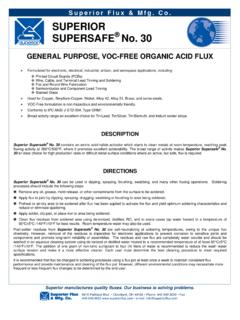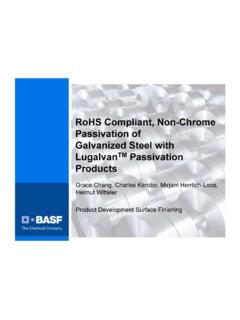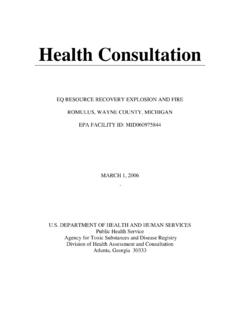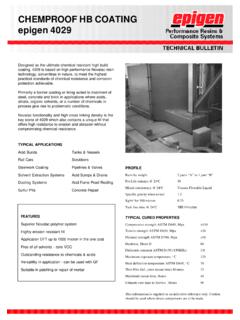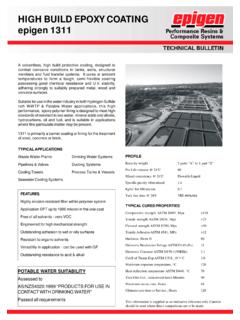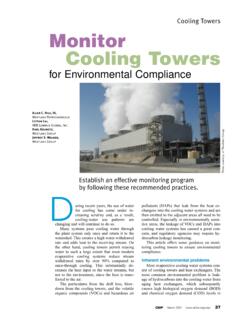Transcription of Ozone
1 Ozone Crops Executive Summary Ozone was petitioned for use as a gas that is injected into soil under plastic mulch for weed control. An additional request was made for use as an antimicrobial agent to clean irrigation lines. Ozone may also be used to treat soil for soil borne pathogens, and this was also considered in this review. In all these types of use Ozone gas (O3) is generated on-site using an electrically powered corona discharge Ozone generator. Ozone is a bluish explosive gas or blue liquid. It is found naturally in the atmosphere at sea level contains an Ozone concentration at very low levels, but is also an air pollutant and a component of smog, reaching tenfold or higher levels in cities at times. Although it is a pollutant and health hazard in the lower atmosphere, naturally occurring Ozone is produced in the outer atmosphere by the photoreaction of solar ultraviolet (UV) radiation on oxygen protecting the earth from excessive radiation.
2 Ozone decomposes spontaneously in water and is a very reactive oxidizing agent with a short half-life. It is used to disinfect water and to oxidize color and taste contaminants in water. It is also increasingly used for disinfection purposes of food and food contact surfaces and is permitted by the National organic Standards for use in organic processing (including post harvest handling) with no restrictions. Two reviewers felt that Ozone should be permitted for use in organic crop production, though limited to use for cleaning irrigation lines, weed control and for soilborne pathogen control. One of the reviewers in favor of use found that this type of usage is a relatively new technique with unreliable results for pathogen control, and noted some reservations regarding possible surface crusting and loss of soil structure when used for weed control. One reviewer objected strongly to use of a a known and problematic air pollutant in organic farming and described hazards to workers and those downwind of application, negative impact on soil humic acid fraction, plant damage, and lack of evidence of effect on soil microorganisms.
3 This reviewer did not object to use to treat irrigation water when Ozone can be recaptured to prevent off- gassing into the environment. Summary of TAP Reviewer's Analyses1. Synthetic/ Allow without Allow only with Nonsynthetic restrictions? restrictions? Synthetic (3-0) No (3) Yes (2). Yes (0) No (1). Identification Chemical Names: Ozone , triatomic oxygen, O3 CAS Number: 100028-15-6. Other Name: Trioxygen Other Codes: NIOSH RTECS #RS8225000. Trade Names: SoilZone, Triox Characterization Composition: Ozone (O3) is triatomic oxygen. 1 This Technical Advisory Panel (TAP) review is based on the information available as of the date of this review. This review addresses the requirements of the organic Foods Production Act to the best of the investigator's ability, and has been reviewed by experts on the TAP. The substance is evaluated against the criteria found in section 2119(m) of the OFPA [7 USC 6517(m)]. The information and advice presented to the NOSB is based on the technical evaluation against that criteria, and does not incorporate commercial availability, socio-economic impact, or other factors that the NOSB and the USDA may want to consider in making decisions.
4 August 14, 2002 National organic Standards Board Technical Advisory Panel Review Page 1 of 1. Compiled by OMRI for the USDA National organic Program NOSB TAP Review Compiled by OMRI Ozone Crops Properties: Ozone is a bluish, explosive gas or blue liquid. It has a characteristic pungent odor that is detectable at concentrations as low as to ppm. At greater concentrations it is irritating to eyes and the respiratory tract and at high concentrations Ozone may be fatal. It is a strong oxidizing agent, mp 193o C, bp C. It is sparingly soluble in water. At 20o C, solubility of 100 percent Ozone is 570mg/L (Richardson, 1994). Atmosphere at sea level contains an Ozone concentration of about ppm (Budavari, 1996). In cities with smog conditions Ozone concentration may reach ppm or higher at times. (Francis, 1997) Ozone decomposes spontaneously in water (US EPA, 1999). The reaction generates hydroxyl free radicals, which are very reactive oxidizing agents but have a half-life of microseconds.
5 In aqueous solution, Ozone can react by direct oxidation of compounds or can oxidize compounds by hydroxyl free radicals that are produced during Ozone decomposition. How Made: Ozone is usually formed by combining an oxygen molecule with an oxygen atom in an endothermic reaction. Naturally occurring Ozone is produced in the outer atmosphere by the photoreaction of solar ultraviolet (UV) radiation on oxygen. At ground level, Ozone may be produced by reactions caused by changes in entropy, water falling on rocks in a waterfall. Ozone is also produced by photoreactions with nitrogen oxides (NOx) and volatile organic compounds (VOC) from industrial emissions, vehicles and other sources (US EPA, 1999). Because Ozone is unstable it is generated at the point of use. It can be generated by irradiating oxygen-containing gas with UV. light and other technologies but the primary industrial method is by the corona discharge method. The oxygen containing gas is passed through two electrodes separated by a dielectric and a discharge gap.
6 When voltage is applied to the electrodes, electrons flow across the gap and provide energy for the disassociation of oxygen molecules, which leads to the formation of Ozone (US. EPA, 1999). There are generally four system components to an Ozone generating process: a power source or Ozone generator, a gas source, an Ozone delivery system and an off-gas destruction system. The gas source may be air, high purity oxygen or a combination of the two (US EPA, 1999). Air feed systems are more complicated than liquid oxygen feed systems because the air must be clean, dry, free of contaminants and with a maximum dew point of -60o C to prevent damage to the generator. Specific Uses: Ozone has been used in Europe to treat drinking water for more than 100 years (US EPA, 1999). Ozone in the United States has been used to disinfect water and to oxidize color and taste contaminants in water. It is increasingly used for disinfection purposes. The petitioned use is for the use of Ozone for weed control (Pryor 2001) with an additional request for use as an antimicrobial agent to clean irrigation lines as an alternative to chlorine (Herman 2002).
7 In addition, the use of Ozone for control of soil borne pathogens will be considered in this review. In all these types of use Ozone would be generated on site. Ozone gas for weed control is used in combination with plastic mulch and is applied in a gaseous form. The target treatment area is the space between the plastic mulch and either the drip irrigation tubing if it is buried or the soil surface if drip tubing is not buried. Ozone is applied under the mulch before the crop is planted. It has also been applied once the crop is in place (Pryor, 1999; Pryor, 2001). It may be applied through drip tape, which can later be used for crop irrigation. Ozone oxidizes plant tissue and weakens or kills emerging weeds. Ozone treatment for weed control may be used in combination with soil solarization. As described in the petition, Ozone for weed control may be applied at rates of 2 lbs/acre with a total number of applications ranging from 7-30 depending on weed species.
8 Ozone uses for control of soil borne pathogens has been tested at rates ranging from 50-400 lbs per acre (Pryor, 1999). It can be applied through drip tubing under plastic mulch or by various methods of direct injection (Pryor 1996, 1997). Ozone can be used to treat or prevent clogged drip irrigation systems by at least two methods. Recycled irrigation water can be treated with Ozone before reuse. (NIDO, 1997) A requested additional use is to inject Ozone into the irrigation lines to act as an antimicrobial agent (Herman 2002). This seems to be a fairly new use with little information to describe the method. One industry writer reports that the gas is generated on site in a closed system and dissolved in water under pressure, and that undissolved gas is collected and disposed of by means of a special separator to avoid accumulation of gas bubbles in the system (Hassan, undated). August 14, 2002 Page 2 of 2. NOSB TAP Review Compiled by OMRI Ozone Crops Action: Ozone is a strong oxidizing agent and very corrosive.
9 In plants, it can cause membrane lysis and necrotic lesions. It may affect photosynthesis and generally represses various genes (Sandermann, 1996). It is germicidal against a wide range of organisms including bacteria, viruses and protozoa. In bacteria, it attacks the bacterial membrane, disrupts enzymes and affects nucleic acids (EPA, 1999). In viruses, Ozone modifies the viral capsid and may break the protein. Combinations: Not sold in combinations. Status Historic Use: Historically Ozone has been used to disinfest and oxidize pathogens and contaminants from drinking water. It was first used in the Netherlands in 1893. Ozone was used in Los Angeles, California in 1987 to treat drinking water and by 1998, 264 water treatment plants in the were using Ozone (US EPA, 1999). Since the implementation of the Surface Water Treatment Rule the use of Ozone for primary disinfection of water has increased (EPA, 1999). Use as a soil treatment to kill living organisms is a relatively recent invention (Pryor, 1996).
10 OFPA, USDA Final Rule: Ozone is listed for use in post-harvest handling and processing (7 CFR (b)(20). It could be considered a production aid under 7 USC 6518(c)(1)(B)(i). Regulatory: EPA/NIEHS/Other Sources The EPA sets standards for Ozone levels under the National Ambient Air Quality Standards as required by the Federal Clean Air Act. EPA considers Ozone producing equipment to be pesticidal devices.' Ozone generation is subject to pesticide worker safety requirements (40 CFR 170). Ozone is subject to the National Primary Drinking Water Regulations under the Safe Drinking Water Act because it is used as a disinfectant in water treatment to kill pathogens. (40 CFR ). FDA considers Ozone to be GRAS as a direct food additive and allows the use of Ozone as an antimicrobial agent for bottled water and food processing (21 CFR ). Bottled water maximum residual permitted Ozone level is mg/l at bottling. OSHA: 29 CFR Subpart Z. Transitional Limit: PEL-TWA ppm Final Limit: PEL-TWA ppm; STEL ppm ACGIH: TLV-Ceiling Limit ppm NIOSH Criteria Document: None NFPA Hazard Rating: Health (H): None Flammability (F): None Reactivity (R): None Status Among Certifiers California Certified organic Farmers (CCOF) CCOF Certification Handbook (rev.))
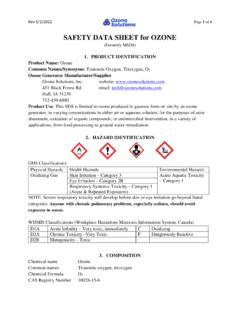
![SAFETY DATA SHEET [formerly MSDS] 1 PRODUCT …](/cache/preview/b/8/1/9/4/d/b/f/thumb-b8194dbf3233d95ad71de2848134ba9c.jpg)
